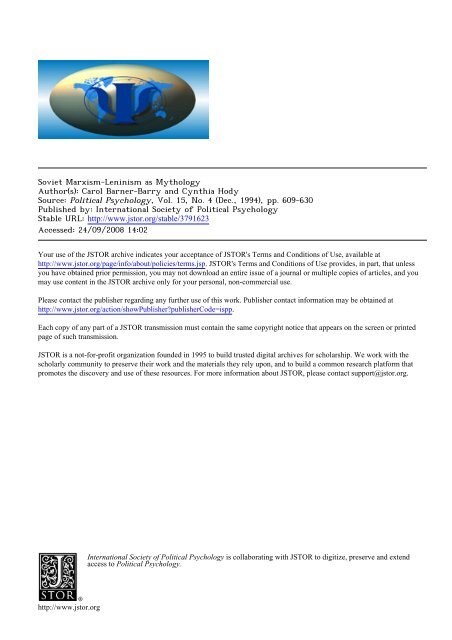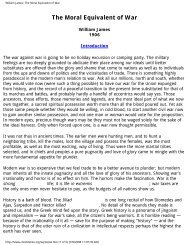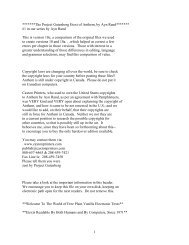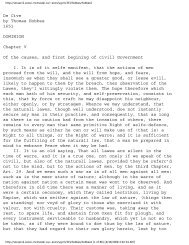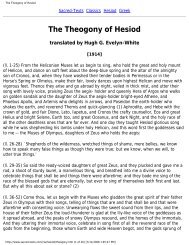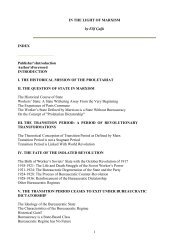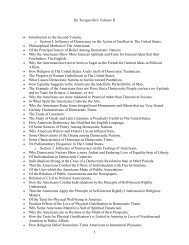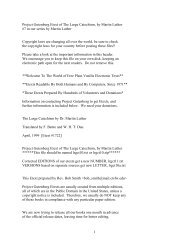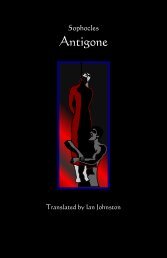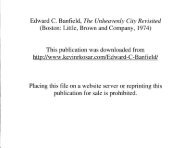Carol Barner-Barry and Cynthia Hody Source - Xet.es
Carol Barner-Barry and Cynthia Hody Source - Xet.es
Carol Barner-Barry and Cynthia Hody Source - Xet.es
- No tags were found...
Create successful ePaper yourself
Turn your PDF publications into a flip-book with our unique Google optimized e-Paper software.
Soviet Marxism-Leninism as MythologyAuthor(s): <strong>Carol</strong> <strong>Barner</strong>-<strong>Barry</strong> <strong>and</strong> <strong>Cynthia</strong> <strong>Hody</strong><strong>Source</strong>: Political Psychology, Vol. 15, No. 4 (Dec., 1994), pp. 609-630Published by: International Society of Political PsychologyStable URL: http://www.jstor.org/stable/3791623Acc<strong>es</strong>sed: 24/09/2008 14:02Your use of the JSTOR archive indicat<strong>es</strong> your acceptance of JSTOR's Terms <strong>and</strong> Conditions of Use, available athttp://www.jstor.org/page/info/about/polici<strong>es</strong>/terms.jsp. JSTOR's Terms <strong>and</strong> Conditions of Use provid<strong>es</strong>, in part, that unl<strong>es</strong>syou have obtained prior permission, you may not download an entire issue of a journal or multiple copi<strong>es</strong> of articl<strong>es</strong>, <strong>and</strong> youmay use content in the JSTOR archive only for your personal, non-commercial use.Please contact the publisher regarding any further use of this work. Publisher contact information may be obtained athttp://www.jstor.org/action/showPublisher?publisherCode=ispp.Each copy of any part of a JSTOR transmission must contain the same copyright notice that appears on the screen or printedpage of such transmission.JSTOR is a not-for-profit organization founded in 1995 to build trusted digital archiv<strong>es</strong> for scholarship. We work with th<strong>es</strong>cholarly community to pr<strong>es</strong>erve their work <strong>and</strong> the materials they rely upon, <strong>and</strong> to build a common r<strong>es</strong>earch platform thatpromot<strong>es</strong> the discovery <strong>and</strong> use of th<strong>es</strong>e r<strong>es</strong>ourc<strong>es</strong>. For more information about JSTOR, please contact support@jstor.org.International Society of Political Psychology is collaborating with JSTOR to digitize, pr<strong>es</strong>erve <strong>and</strong> extendacc<strong>es</strong>s to Political Psychology.http://www.jstor.org
Political Psychology, Vol. 15, No. 4, 1994Soviet Marxism-Leninism as Mythology<strong>Carol</strong> <strong>Barner</strong>-<strong>Barry</strong>Department of Political ScienceUniversity of Maryl<strong>and</strong>Baltimore County Campus<strong>Cynthia</strong> <strong>Hody</strong>Department of Political ScienceUniversity of Maryl<strong>and</strong>Baltimore County CampusMarxism-Leninism is usually regarded as an ideology, an intellectual construct.For the overwhelming majority of the Soviet people, however, it was pr<strong>es</strong>ented ina form that was more mythological than ideological. This article analyz<strong>es</strong> themythological use of the main ideas of Marxism-Leninism during the Soviet period.This mythology was used as one of the major bas<strong>es</strong> for building a commonSoviet national identity among the myriad ethnic groups living on Soviet soil. Therise of nationalism during the Gorbachev period <strong>and</strong> the rapid disintegration ofthe Soviet Union highlight the failure of the Soviet leadership to build a commonSoviet identity that might have formed the basis for a more stable Soviet nationstate.KEY WORDS: mythology; Soviet Union; Marxism-Leninism; persuasion; social control; nationbuildingHuman beings are myth-making animals. As far back in history as anyonecan trace, we have been creating <strong>and</strong> using myths. This fact alone would indicatethat mythology fills some basic <strong>and</strong> continuing human need. When most peoplethink of myths, however, they tend to think of them as fantastic stori<strong>es</strong> concoctedby primitive people who needed some way of explaining what they found bewilderingin the world around them. Most of us are quite sure that we do not have,or need, myths because we have science to look to for explanations (Wolin,1985). Even if there is much that we still do not underst<strong>and</strong> about our world, th<strong>es</strong>cientific method giv<strong>es</strong> us confidence that, in time, r<strong>es</strong>earch will bring us underst<strong>and</strong>ing.After all, we like to think of ourselv<strong>es</strong> as rational, logical beings whowill be able-sooner or later-to figure things out. Nothing could be fartherfrom the truth than the notion that we live in a myth-free world.Contemporarily, a myth is "a widely accepted belief that giv<strong>es</strong> meaning toevents <strong>and</strong> that is socially cued, whether or not it is verifiable" (Edelman, 1977,6090162-895X ? 1994 International Society of Political PsychologyPublished by Blackwell Publishers, 238 Main Street, Cambridge, MA 02142, USA, <strong>and</strong> 108 Cowley Road, Oxford, OX4 IJF, UK.
610<strong>Barner</strong>-<strong>Barry</strong> <strong>and</strong> <strong>Hody</strong>p. 3). We all embrace myths about ourselv<strong>es</strong> <strong>and</strong> our world, but we usually do notcall them myths or even recognize them as such. We need th<strong>es</strong>e myths to help us tounderst<strong>and</strong> ourselv<strong>es</strong> <strong>and</strong> our place in the world-perhaps even the universe.Many of th<strong>es</strong>e are political myths, tal<strong>es</strong> which help us to make sense of ourpolitical past, pr<strong>es</strong>ent, <strong>and</strong> future (Nimmo & Combs, 1980). They can also persuadeus to act in certain ways <strong>and</strong>, for this reason, can be powerful aids in the impositionof social control on a population. When political myths are succ<strong>es</strong>sful in theirpersuasive role, people do not think of them as myths; they believe them to be true.And they may be. The truth or falsity of a myth is not what giv<strong>es</strong> it itspsychological persuasiven<strong>es</strong>s. Most myths about the modem world are somecombination of fact <strong>and</strong> fiction. What is important, however, is that peopleinternalize the myths <strong>and</strong> their valu<strong>es</strong>. To internalize a myth is to accept itspersuasive influence <strong>and</strong> to act on that basis. When we do, we find out actions <strong>and</strong>attitud<strong>es</strong> "intrinsically rewarding" because they are "congruent with" our valu<strong>es</strong>ystems (Kelman, 1958, p. 53). That is to say, because we believe the valu<strong>es</strong> inmyths are right <strong>and</strong> proper, we use myths as guid<strong>es</strong> for our own attitud<strong>es</strong> <strong>and</strong>behavior. And, further, we feel virtuous about doing so. The potential for myths toplay a persuasive role in our liv<strong>es</strong> is related to their characteristics <strong>and</strong> functions.This article will examine the attempt by the Soviet leadership to use mythologyto persuade the Soviet people that they were a single people with a commonidentity that transcended their traditional ethnic roots <strong>and</strong>, thus, to build a Sovietnation. The major theoretical framework concerning mythology will be takenfrom Nimmo <strong>and</strong> Combs's book Subliminal Politics (1980) with some modifications.The first topic will be the characteristics <strong>and</strong> functions of myths as theywere used in the Soviet Union. Included in this discussion will be an examinationof Lenin as mythic hero. Then there will be an exploration of the Soviet mastermyths. Finally, there will be a discussion of the failure of this mythic system tocreate a common identity among the various ethnic groups making up the Sovietsystem. This, in turn, will be related to the rapidity with which the Soviet Unionfell apart after the failed coup of 1991.THE CHARACTERISTICS AND FUNCTIONS OF MYTHSAccording to Nimmo <strong>and</strong> Combs (1980), moder myths have five basiccharacteristics.1 First, they are believable. As was noted above, they may betrue, partly true, or blatantly false; it do<strong>es</strong> not matter. What matters is that it is possiblefor perfectly ordinary, reasonable people to regard them as true. One Sovietexample was the belief that Lenin was a wise, benevolent, <strong>and</strong> heroic leader.Because Lenin conveniently died before the Soviet Union took on a relativelystable form <strong>and</strong> because of the way the official historians pr<strong>es</strong>ented Lenin <strong>and</strong> his'In their book they list six. The sixth, however, is qualitatively different from the other five <strong>and</strong> thusis discussed separately here.
Soviet Marxism-Leninism as Mythology611life, it was easy for Soviet citizens to believe that he was one of the truly great<strong>and</strong> good figur<strong>es</strong> of history. Thus, right up to the collapse of the Soviet Union(Smart, 1990), Lenin served as a believable mythic hero for the Soviet peoplebecausehe did lead the Bolshevik Revolution <strong>and</strong> because information about himwas carefully controlled <strong>and</strong> orch<strong>es</strong>trated by the Communist Party of the SovietUnion (CPSU) as part of its use of persuasion as a social control mechanism.Second, myths are created through a social proc<strong>es</strong>s. A myth can emergefrom a group of people spontaneously-seemingly without conscious direction.Most of the major Soviet myths, however, were at least cultivated, if not createdfrom scratch, by the Soviet leadership. Again, we can use Lenin as an example.After the 1917 Bolshevik Revolution, Lenin was hailed as the single most importantperson bringing about the victory of the "people" over their "oppr<strong>es</strong>sors." Inthose first heady days after the Bolshevik victory, there were many who didbelieve in a certain <strong>and</strong> glorious communist future. They began to endow Leninwith mythic qualiti<strong>es</strong>-to make him a mythic hero (Tumarkin, 1983, pp. 64-111). After Lenin's death <strong>and</strong>, particularly, after Stalin's death, conscious measur<strong>es</strong>were taken by the Soviet leadership to encourage <strong>and</strong> strengthen his mythicstatus. In this way, there evolved a cult of Lenin which was "the collectiveconstruction of a credible reality" (Nimmo & Combs, 1980, p. 17; Tumarkin,1983). Long after glasnost had led to the discrediting of other Soviet leaders,belief in the mythic qualiti<strong>es</strong> of Lenin persisted. For example, one member of theCPSU's Central Committee put it this way: "For me, Lenin was the man whoprovided us with our Soviet Union <strong>and</strong> all that we became-an advanced country.The mistak<strong>es</strong> were not Lenin's. The mistak<strong>es</strong> came in carrying out Lenin'sline. ... I tell you straight that we have a genius in Lenin" (The WashingtonPost, November 1, 1988, p. 27).Third, a myth is like a drama. It is a story with a beginning, a middle <strong>and</strong> anend. Lenin's life furnished just such a story. There he was, a normal boy growingup in an ordinary upper-middle-class family. Then his beloved <strong>and</strong> brave olderbrother got involved in revolutionary activiti<strong>es</strong> in St. Petersburg <strong>and</strong> was executedby the evil tsarist regime. Lenin was radicalized by this <strong>and</strong> by the blatantdiscrimination he experienced as the relative of a convicted anarchist. He selfl<strong>es</strong>slydecided to sacrifice all <strong>and</strong> devote his life to overthrowing the evil tsaristregime, the cause for which his brother gave his life. And, finally, after manystruggl<strong>es</strong> he emerged triumphant-a savior of the common people of Russia.Soon afterward he was the victim of an assassination attempt which hastened hispremature death. What more dramatic story could one wish?Fourth, once a story has attained mythic status, it is seldom qu<strong>es</strong>tioned.This was certainly true of the Lenin myth; Lenin became an object of unqu<strong>es</strong>tioning,almost religious, veneration. The Lenin mausoleum in Red Square became a"holy shrine" to which people made pilgrimag<strong>es</strong>: "To this ritual centre bothindividual persons <strong>and</strong> society (in the form of its repr<strong>es</strong>entative groups) [came] todraw moral strength at crisis points, to give heightened significance to important
612<strong>Barner</strong>-<strong>Barry</strong> <strong>and</strong> <strong>Hody</strong>events, to give an account of important missions accomplished, to display <strong>and</strong>rejoice in succ<strong>es</strong>s<strong>es</strong> or just to give homage" (Lane, 1981, p. 210). Lenin'smemory was to be revered, not qu<strong>es</strong>tioned. It was significant "that[until thevirtual end of Soviet rule] one never [found] any of the many portraits of Lenindefaced" (Lane, 1981, p. 213).Also, during most of the Soviet period, there was little public criticism ofLenin, even from dissidents. In fact, when some historians-emboldened byglasnost-began to qu<strong>es</strong>tion the Lenin myth, they were greeted with shock. Oneof the first of the historians who took a more skeptical look at Lenin's life <strong>and</strong>work, Selyunin, observed that it was personally difficult for him to qu<strong>es</strong>tion theLenin myth. This was <strong>es</strong>pecially true, since he found himself sugg<strong>es</strong>ting thatLenin had started the proc<strong>es</strong>s that let to the forced labor camps of Stalin: "Underst<strong>and</strong>,it's not a joy to write this. My jaws lock sometim<strong>es</strong>. But it is nec<strong>es</strong>sary.... We cannot repeat this" (The Washington Post, June 7, 1988, p. A17).Fifth, myths have a practical purpose. In the case of political myths, thatpurpose can be social control through the mechanism of persuasion. In otherwords, myths can be used to persuade people to hold certain political beliefs <strong>and</strong>attitud<strong>es</strong>-<strong>and</strong>, when nec<strong>es</strong>sary, to act on them. In this sense, the myth of Leninwas very practical as a vehicle which could be put to persuasive use by the CPSUto help it create a common Soviet identity. For a country that had, until recently,high levels of illiteracy, the use of concrete, nonverbal symbols <strong>and</strong> easilyunderstood stori<strong>es</strong> was politically important. The more abstract <strong>and</strong> intellectualideological formulations of some of the same information were beyond thecomprehension of most of the Soviet people.Lenin was a real person who could be (<strong>and</strong> was) depicted in photographs,statu<strong>es</strong>, paintings, books, movi<strong>es</strong>, <strong>and</strong> plays. All of th<strong>es</strong>e could lay claim toconveying some vital "truth" about him <strong>and</strong> the country he helped create. He hadbeen fl<strong>es</strong>h <strong>and</strong> blood with all of the joys <strong>and</strong> sorrows that impli<strong>es</strong>-someonepeople could relate to personally. Children were taught to call him "UncleLenin." At the same time, as a symbol, he embodied the valu<strong>es</strong> <strong>and</strong> norms ofMarxism-Leninism <strong>and</strong> the Bolshevik Revolution. The combination of his veryhuman image with a carefully selected set of interpretations of reality was intendedto promote allegiance to the Soviet Union. This, in turn, was linked toloyalty to the particular regime in power at the time.2 During most of the Sovietperiod it seemed to succeed very well-at least on the surface. As Friedrich <strong>and</strong>Brzezinski noted many years ago, myths "play a vital role in totalitarian dictatorships"(1965, p. 91).Even while the Soviet Union was disintegrating, many people found thed<strong>es</strong>truction of the myth of Lenin far more threatening than negative revelationsabout any other Soviet person or event. As one highly placed supporter of2While the basic information conveyed remained substantially the same, each regime gave it a unique"spin," sometim<strong>es</strong> changing the interpretation from time to time in order to take into accountdevelopments in the Soviet Union <strong>and</strong> the r<strong>es</strong>t of the world.
Soviet Marxism-Leninism as Mythology613Gorbachev's reform put it: "Remember, the very limited democratic tradition wedo have is in Lenin's NEP [New Economic Policy].3 To begin assaulting thatwould lead to a terrific loss of confidence in people's souls. Millions of peopl<strong>es</strong>till can't believe there was a cult of Stalin. So to take a tough look at Lenin toosoon would not be wise" (The Washington Post, November 1, 1988, p. A21).Thus, Gorbachev <strong>and</strong> his supporters utilized the Lenin myth (<strong>es</strong>pecially his NewEconomic Policy) to mobilize support for per<strong>es</strong>troika, while focusing the hard,cold light of glasnost on Stalin (Smart, 1990).Mythic thinking <strong>and</strong> scientific thinking are two very different proc<strong>es</strong>s<strong>es</strong>. Inscience, the ability to evaluate a proposition using objective, concrete observation,<strong>and</strong> replicable experimentation is central <strong>and</strong> definitive. Myths, however,are made up of symbols <strong>and</strong> stori<strong>es</strong>, objects of belief. By definition, they are notamenable to disproof by any generally agreed-upon method. A myth becom<strong>es</strong>important when people believe it to be true <strong>and</strong> when they act on that belief. If aperson behav<strong>es</strong> as if a myth is true, there is a sense in which-for practicalpurpos<strong>es</strong>-they have made it true. For example, there is no concrete archeologicalevidence that J<strong>es</strong>us lived. Millions of people, however, have spent their liv<strong>es</strong>believing that he did, <strong>and</strong> this fact has had a powerful effect on them <strong>and</strong> on thecourse of history.Myths serve four general functions in people's liv<strong>es</strong> (Nimmo & Combs,1980, pp. 20-24). First, they are easily understood <strong>and</strong>, therefore, make life'sevents easier to grasp <strong>and</strong>, perhaps, to accept. This is particularly importantwhen situations are unavoidable (as in natural disasters) or when a regime wantsto impose hardships on its subjects. The victorious Bolsheviks inherited a l<strong>and</strong>that was, by contemporary European st<strong>and</strong>ards, economically underdeveloped<strong>and</strong> educationally backward. In addition, it had been devastated by World War I<strong>and</strong> the period of War Communism (civil war) which followed the BolshevikRevolution. In order to repair the human <strong>and</strong> material damage inflicted by warfare,as well as to catch up with the more developed European countri<strong>es</strong>, theSoviet regime needed to convince the people to work hard <strong>and</strong> to make tremendouspersonal sacrific<strong>es</strong>. The idea of building a utopian society for their children<strong>and</strong> their children's children was a powerful incentive (Luke, 1985). And so,central to the mythology of the Soviet Union was the idea that its people wereengaged in the building of communism <strong>and</strong> that this effort would r<strong>es</strong>ult in a moreaffluent <strong>and</strong> just society than the world had ever known. The mythology assertedthat deprivation endured in the pr<strong>es</strong>ent was worth it, because the future payoffwould be so great.Second, myths give people rol<strong>es</strong> in life, by providing "a sense of self,wholen<strong>es</strong>s, <strong>and</strong> importance that cold, scientific, technological thought simplycannot supply" (Nimmo & Combs, 1980, p. 23). A central myth of the Soviet3Briefly, Lenin's new Economic Policy in the 1920s encouraged a limited market economy in theSoviet Union, particularly in the form of what we would call small busin<strong>es</strong>s<strong>es</strong>.
614<strong>Barner</strong>-<strong>Barry</strong> <strong>and</strong> <strong>Hody</strong>Union was that they were changing human nature, creating a new type of person:the builder of communism. This was seen as central to the goal of <strong>es</strong>tablishingthe good society-Soviet style (Vasilenko, 1985). People who measured up tothe st<strong>and</strong>ard were considered to be assets to the society <strong>and</strong> to be of high moralworth. What was expected of a builder of communism was the following:-Devotion to the cause of communism, love for the socialist Motherl<strong>and</strong>,for the socialist countri<strong>es</strong>:-Conscientious labor for the good of society: who do<strong>es</strong> not work do<strong>es</strong> noteat;-Concern of each person for the conservation <strong>and</strong> increase of social property;-A high consciousn<strong>es</strong>s of social duty, intolerance toward violations ofsocial inter<strong>es</strong>ts;-Collectivism <strong>and</strong> comradely mutual aid; one for all <strong>and</strong> all for one;-Humane relationships <strong>and</strong> reciprocal r<strong>es</strong>pect between peopl<strong>es</strong>: person toperson-friend, comrade, <strong>and</strong> brother;-Hon<strong>es</strong>ty <strong>and</strong> truthfuln<strong>es</strong>s, moral purity, simplicity, <strong>and</strong> mod<strong>es</strong>ty in social<strong>and</strong> personal life;-Mutual r<strong>es</strong>pect in the family, concern for the upbringing of children;-Irreconcilability toward injustice, parasitism, dishon<strong>es</strong>ty, careerism,greed;-The friendship <strong>and</strong> brotherhood of all the peopl<strong>es</strong> of the U.S.S.R., intolerancetoward nationalistic <strong>and</strong> racial hostility;-Irreconcilability toward the enemi<strong>es</strong> of communism, of the cause ofpeace, <strong>and</strong> of the freedom of nations;-Fraternal solidarity with the workers of all countri<strong>es</strong> <strong>and</strong> with all peopl<strong>es</strong>.(Bogdanova& Kaninina, 1984, pp. 10-11)Taken from the Program of the CPSU which was in effect from 1961 to 1986, thisMoral Code of the Builder of Communism specified what each person could doin order to be part of the creation of a future utopia in the Soviet Union. It offeredpeople identiti<strong>es</strong> d<strong>es</strong>igned to make them feel that they were important actors inthe drama of transforming their country.Third, because myths are shared, they forge bonds between people <strong>and</strong>create community. The idea of community, in the form of the collective, was thecentral organizing principle of the Soviet social order. The builder of communismdid not work alone. He or she was a member of societal subgroups whichcoordinated the effort of individuals, uniting them in working toward commongoals. Membership in collectiv<strong>es</strong> was not optional. When you entered a school ortook a job, you automatically became part of one (Kiprianov& Kuznetsova,1986). The collective connected you to the larger society: "By means of [thecollective] two opposite streams of social activiti<strong>es</strong> meet-from society to theindividual <strong>and</strong> from the individual to society. As the direct means by which a
Soviet Marxism-Leninism as Mythology615person carri<strong>es</strong> out his life's work, the collective's functions draw him into the lifeof society" (Vasilenko, 1985, p. 49). For the adult, the collective was supposedto be "family," the place where she spends her "most active <strong>and</strong> fruitful time"(Vasilenko, 1985, p. 49). Thus, the collective was intended to createcommunity-binding people together by strong social bonds.The myth of the collective, in turn, was tied to the wider social myth whichwas about the function collectiv<strong>es</strong> supposedly played in the society. In reality, thecollective was chiefly a means of social <strong>and</strong> political control over the individual4(Dontsov, 1984; Kassof, 1965, p. 42; <strong>Barry</strong> & <strong>Barner</strong>-<strong>Barry</strong>, 1991, pp. 32-33).In the mythology, it was pr<strong>es</strong>ented as the way in which individuals b<strong>and</strong>edtogether in order to realize the utopian goals of the Soviet Union. Article 8 of theU.S.S.R. Constitution adopted in 1977 stated thatLabor collectiv<strong>es</strong> take part in discussing <strong>and</strong> deciding state <strong>and</strong> public affairs, in planningproduction <strong>and</strong> social development, in training <strong>and</strong> placing personnel, <strong>and</strong> in discussingmatters pertaining to the management of enterpris<strong>es</strong> <strong>and</strong> institutions, the improvement ofworking <strong>and</strong> living conditions, <strong>and</strong> the use of funds allocated for developing production<strong>and</strong> for social <strong>and</strong> cultural purpos<strong>es</strong> <strong>and</strong> financial incentiv<strong>es</strong>. (As translated in <strong>Barry</strong> &<strong>Barner</strong>-<strong>Barry</strong>, 1991, p. 336)As a d<strong>es</strong>cription of the actual role collectiv<strong>es</strong> played, this is not accurate. Theirimpact did not even approximate what is sugg<strong>es</strong>ted. As part of the mythicalbuilding of communism, however, collectiv<strong>es</strong> were cast in the role of the organizingforce which made things happen. This myth was supposed to give peoplethe feeling that, through the decision-making function of their collectiv<strong>es</strong>, theywere important actors in shaping a utopian future for the U.S.S.R.Finally, <strong>and</strong> perhaps most importantly from the point of view of the Sovietexperience, myths can be manipulated to achieve goals. Clearly, if an individualidentified herself as a builder of communism <strong>and</strong> strived to conform to the MoralCode, she became a more effective means for realizing the goals of the leadership.With the people organized into collectiv<strong>es</strong>, their work could be channeled<strong>and</strong> monitored so that it became easier to carry out the polici<strong>es</strong> of the CPSU.When people accepted the mythic hero, Lenin, as a role model, they brought tothe experience of "building communism" the ideas <strong>and</strong> valu<strong>es</strong> that the regimewas associating with Lenin. This made it easier for them to identify themselv<strong>es</strong>as engaged in a heroic task, following in the footsteps of their founding father<strong>and</strong> mythic hero. The CPSU was, after all, leading them, <strong>and</strong> it was the party ofLenin.The mythology about Lenin <strong>and</strong> the building of communism did not exist inisolation. It was part of the master mythology of the Soviet state. Master mythsare "broad, overarching myths that constitute the collective consciousn<strong>es</strong>s of anentire society" (Nimmo & Combs, 1980, p. 26). In their efforts to control the4This phenomenon was not unique to the Soviet period. Its roots stretched much farther back intoRussian history (Keenan, 1986).
616<strong>Barner</strong>-<strong>Barry</strong> <strong>and</strong> <strong>Hody</strong>beliefs of the Soviet people, the leadership attempted to create a set of mastermyths that would channel the emotions <strong>and</strong> efforts of Soviet citizens in d<strong>es</strong>ireddirections.THE SOVIET MASTER MYTHSThere are three basic typ<strong>es</strong> of master myth (Nimmo <strong>and</strong> Combs, 1980,pp. 26-27). The first is the foundation myth, which deals with the story of acountry's origin. The second is the sustaining myth, "a core belief, a centralmotif, in which the ideal culture patterns are embedded . .. " (Tucker, 1987,p. 22). The third is the <strong>es</strong>chatological myth, the story of the country's ultimated<strong>es</strong>tiny. In one way or another, the revolutionary experience <strong>and</strong> an extremelysimplified Marxist-Leninist ideology lay at the heart of th<strong>es</strong>e master myths. Bothwere subject to modification <strong>and</strong> distortion to serve the purpos<strong>es</strong> of those currentlyin power. But, although there were frequent chang<strong>es</strong> in the details, thelarger picture painted by the Soviet master myths remained basically stable overtime.The Foundation MythThe Bolshevik Revolution in 1917 ushered in a "revolutionary massmovementregime under single-party [CPSU] auspic<strong>es</strong>" (Tucker, 1971, p. 7).Thus it marked the symbolic founding of the Soviet Union, <strong>and</strong> the mythologywhich grew up around the revolutionary period became the foundation myth ofthe U.S.S.R. The mythic interpretation of the Bolshevik Revolution wassummed up nicely at the beginning of a book entitled The Soviet Way of Lifewhich was published the same year Gorbachev came to power:The Great October Socialist Revolution marked a basic turning point in the historical fateof our Motherl<strong>and</strong>, marking the beginning of the formation of socialist civilization. TheLeninist concept of a proletarian revolution <strong>and</strong> the construction of socialism based on theteachings of Marx <strong>and</strong> Engels ideologically armed the Party <strong>and</strong> the working class in theirstruggle against the bourgeoisie for a new life which would bring good fortune to theworkers. (Kas'ianenko, 1985, p. 9)Several things should be noted about this summarized version of the foundationmyth.First, the Soviet Union is implicitly regarded as an extension of the RussianEmpire which had been overthrown in 1917. And, in truth, the country whichinitially emerged was nominally Russian. The Soviet Union did not officiallycome into being until 1922. Thus, both the focus of the Soviet foundation myth<strong>and</strong> the major Soviet founding father (Lenin) were Russian. The many otherethnic groups played bit parts, if they were given credit for participating at all.
Soviet Marxism-Leninism as Mythology617This is particularly important, since the Soviet leadership subsequently tried topersuade both the Russian <strong>and</strong> the non-Russian ethnic groups to internalize acommon Soviet national identity. This effort failed, in part, because it was basedon a foundation myth that related almost exclusively to one ethnic group, theRussians. By the time of Gorbachev, that group was about to become a minority(albeit a privileged minority) within the Soviet population.5 Thus, the very basisof the foundation myth excluded a large portion of the Soviet citizenry, whilefeeding the belief of one ethnic group that it was naturally more important.Second, it is asserted that the Bolshevik Revolution <strong>es</strong>tablished a new formof "civilization," a socialist civilization. In context, the phrase impli<strong>es</strong> that allprevious forms of civilization were seriously lacking. This, in effect, dismiss<strong>es</strong>the historical <strong>and</strong> cultural heritag<strong>es</strong> of all of the constituent peopl<strong>es</strong> of the SovietUnion, some of whom-like the Central Asians-could boast of a rich culturalheritage. Even the Russian tsarist heritage was dismissed, in that it was theheritage of the official revolutionary "enemy." By 1985, there were few peoplewho had personal memori<strong>es</strong> of the days immediately after the Revolution when anew world of possibiliti<strong>es</strong> seemed to have opened up <strong>and</strong> when it was easy to be a"true believer." As a r<strong>es</strong>ult, the Soviet foundation myth had very little historicalor emotional appeal for most of the citizens of the Soviet Union during theGorbachev era.Third, this foundation myth sets forth a story about a d<strong>es</strong>ired social order<strong>and</strong>the social order involved was a Eurocentric social order. Although the youngSoviet state turned inward to provide its people with the isolation from theoutside world their rulers needed to exact the human effort <strong>and</strong> sacrifice nec<strong>es</strong>saryfor the rapid transformation of the Soviet political-economic system, themodel was primarily that of the modernized W<strong>es</strong>t. The ancient civilizations ofplac<strong>es</strong> like Georgia, Armenia, <strong>and</strong> the Muslim republics were ignored. In addition,the foundation myth lacked reference to the natural environment or thehuman life cycle, both of which are classic mythical them<strong>es</strong>. This led to a ritualsymbolism "developed in a moder industrial society which [was] characterizedby its remoten<strong>es</strong>s from the 'natural' <strong>and</strong> by its disdain of the 'physiological'"(Lane, 1981, p. 192). Thus, the foundation myth was not based on anythingwhich all of the Soviet people had in common. In fact, with its emphasis on aEuropeanized <strong>and</strong> Russianized utopia, it was based on much which potentiallydivided them.Finally, the foundation myth asserted that the new socialist civilization wasthe creation of the working class along with their vanguard, the CPSU, <strong>and</strong> that itwould usher in a world of "good fortune" for the workers. To start with, theBolshevik Revolution was hardly a creation of the working class. Although many5At the time of the last Soviet census in 1989, the Russians made up 50.8% of the Soviet population(Narodnoe khoziaistvo SSSR v 1990 g., 1991, p. 77).
618<strong>Barner</strong>-<strong>Barry</strong> <strong>and</strong> <strong>Hody</strong>workers <strong>and</strong> peasants participated, it was first <strong>and</strong> foremost the creation of asmall, tightly knit group of prof<strong>es</strong>sional revolutionari<strong>es</strong>. The new "socialistcivilization" which followed was largely the creation of the CPSU led by Stalin.And, only by strictly limiting the availability of information about the worldoutside the Soviet Union could the CPSU leadership sustain the belief that thisnew life had brought "good fortune" to the workers.Another important part of the foundation myth was its tie to an officialideology, Marxism-Leninism, <strong>and</strong> its interpretation of the basic nature <strong>and</strong>sourc<strong>es</strong> of that ideology. According to Christenson et al. (1981, p. 4), "a politicalideology is a system of beliefs that explains <strong>and</strong> justifi<strong>es</strong> a preferred politicalorder, either existing or proposed, <strong>and</strong> offers a strategy (institutions, proc<strong>es</strong>s<strong>es</strong>,programs) for its attainment." Thus, ideologi<strong>es</strong> are very much like myths.Unlike myths, however, reasonably well-developed ideologi<strong>es</strong> likeMarxism-Leninism are primarily appeals to rationality <strong>and</strong> logic, rather than theemotions. They attempt to set forth an intellectually viable, integrated beliefsystem-cognitive construct. And, in the early works of Marx, "we find both apreoccupation with the problem of achieving a morally coherent world <strong>and</strong> arudimentary vision of a future communist society . . . nothing that can be d<strong>es</strong>cribedas a mythical account" (Tudor, 1972, pp. 115-116). Only with thepublication of The German Ideology, did Marx lend his ideological system tomyth-making. Here, "for the first time, the d<strong>es</strong>tiny of the revolutionary proletariat[is] set forth as a dramatically coherent sequence of events" (Tudor, 1972,p. 116). Certainly, the ideology which dominated the Soviet political-economicsystem had a strong intellectual core derived from the writings of Marx <strong>and</strong>Engels, supplemented by the writings of Lenin.While some ideologi<strong>es</strong> are clearly different from myths, others contain acertain amount of overlap embodied in some of their important characteristics<strong>and</strong> functions. First of all, like master myths, ideologi<strong>es</strong> offer "an interpretationof the past, an explanation of the pr<strong>es</strong>ent, <strong>and</strong> a vision of the future" (Christensonet al., 1981, p. 4). However, rather than being formulated in dramatic form, theypr<strong>es</strong>ent "an ordered arrangement of logically related ideas offering an explanation<strong>and</strong> vision of human d<strong>es</strong>tiny." (Christenson et al., 1981, p. 5) In otherwords, myths are primarily d<strong>es</strong>igned to appeal to our feelings <strong>and</strong> our taste forthe dramatic; ideologi<strong>es</strong> are primarily d<strong>es</strong>igned to appeal to our capacity for logic<strong>and</strong> intellectual thought.What do they have in common? In the Soviet case, there were five majorsimilariti<strong>es</strong>. Both the mythology <strong>and</strong> the ideology were, first of all, simplificationsof complex political realiti<strong>es</strong>. Second, they were d<strong>es</strong>igned to be persuasive,to motivate the population from top to bottom-the ideology being aimed moreat the intelligentsia, the mythology being aimed more at the poorly educated oruneducated mass<strong>es</strong>. Third, each claimed both truth <strong>and</strong> universality. Fourth, theywere millennial, looking toward a utopian future. Fifth, they had heros, sacreddocuments, <strong>and</strong> rituals.
Soviet Marxism-Leninism as Mythology619In the Soviet Union, there were also important differenc<strong>es</strong>. First, formalMarxist-Leninist ideology was articulated, verbal, systematic, <strong>and</strong> explicit. Itwas easy to pick up a book <strong>and</strong> read the writings of Marx <strong>and</strong> Lenin-they werecertainly abundant. The mythic formulation was to be found in the ubiquitoussymbols <strong>and</strong> slogans, in most works of art, in the agitation <strong>and</strong> propag<strong>and</strong>asystem (AGITPROP), <strong>and</strong> in all but the most advanced sectors of the educationalsystem. Second, Marxism arose in a period of societal str<strong>es</strong>s in W<strong>es</strong>tern Europe<strong>and</strong> continued to be elaborated during a period of growing crisis in Russia. Themythology played a part in the revolutionary period, but it became much moredeveloped as the situation in the new Soviet Union was becoming more stable,<strong>and</strong> it was used to mobilize the people behind the goals of the CPSU. Finally,formal Marxist-Leninist ideology was most attractive to people who were relatingto the Soviet political system in a mainly intellectual way (on the surface, atleast). Its mythological variant was aimed at the general citizenry, at people whowere relating to the Soviet political system on a more emotional level.Over the years after the Bolshevik Revolution, Marxist-Leninist ideologyunderwent many modifications as different Soviet leaders manipulated it for theirown purpos<strong>es</strong>. The core which was tied to the mythology, however, tended toremain reasonably constant. The Soviet leadership tried to use Marxism-Leninism as a source of legitimacy <strong>and</strong> as a tool for persuasion. As a source oflegitimacy, ideology can be used "to justify an existing social system," lendingauthority to the decisions made by the current leadership. As a tool of persuasion,it can be used to project "a d<strong>es</strong>irable future social order," motivating the peopleto work hard to achieve that goal (Plano & Greenberg, 1985, p. 12).How did the foundation myth treat Marxist-Leninist ideology? To return toKas'ianenko:Marx <strong>and</strong> Engels developed a genuinely scientific dialectical-materialistic interpretationof history, substantiating the global-historical mission of the working class, its role in therevolutionary renewal of society. . . . [They] demonstrated the objective nec<strong>es</strong>sity of adictatorship of the proletariat for the accomplishment of the transition from capitalism tocommunism. . . . [They] were the first to attempt to d<strong>es</strong>cribe the communist way of life<strong>and</strong> work.V. I. Lenin scientifically substantiated the path <strong>and</strong> method of eliminating the foundationsof the past, the form of life <strong>and</strong> work of the people <strong>and</strong> the <strong>es</strong>tablishment of asocialist society. Lenin's plan for the building of socialism armed the party with a concreteprogram for the creation of a new way of life by the workers themselv<strong>es</strong>. (Kas'ianenko,1985, pp. 9-10)Thus, the intellectual construct tak<strong>es</strong> on a more dramatic form. This also warrantscloser scrutiny.First, note the use of the term "scientific" (nauchnyi) in connection with thetheori<strong>es</strong> of Marx <strong>and</strong> Engels. Not only are th<strong>es</strong>e theori<strong>es</strong> supposed to be scientific,but they are "genuinely" (podlinno) scientific. The dictionary definition ofthe Russian word for "science" (nauka) isA system of knowledge about the lawful [according to natural law] development ofnature, society <strong>and</strong> thought, <strong>and</strong> also a single branch of such knowledge. Social science.
620<strong>Barner</strong>-<strong>Barry</strong> <strong>and</strong> <strong>Hody</strong>Natural science. ... 2. That which instructs, giv<strong>es</strong> experience, a l<strong>es</strong>son...."(Ozhegov, 1988; emphasis in the original)While English dictionary definitions of "science" encompass this meaning, inpopular usage the term tends to be used in connection with a particular, rigorous,experimental methodology, <strong>and</strong> the theori<strong>es</strong> which inform it. It is not customaryin the English-speaking world to refer to bodi<strong>es</strong> of philosophical thought, likeMarxism, as scientific (e.g. McLellan, 1979).As a tool of persuasion, Marxism-Leninism was repeatedly characterized asscientific, given a status which corr<strong>es</strong>ponded with the purely intellectual (<strong>and</strong>usually quantifiable) theori<strong>es</strong> of the natural scienc<strong>es</strong>. This was easy to do becauseof the way in which the Russian word for science was commonly used. It had itsmythic advantag<strong>es</strong> as well. It gave a weight of inevitability to any idea orprediction which carried the label "Marxism-Leninism." For example, the 1961Program of the Communist Party of the Soviet Union stated: "Socialism willinevitably succeed capitalism everywhere. Such is the objective law of socialdevelopment. Imperialism is powerl<strong>es</strong>s to check the irr<strong>es</strong>istible proc<strong>es</strong>s of emancipation"(as quoted in Kaiser, 1986/87, p. 237).When Marx <strong>and</strong> Engels "demonstrated the objective nec<strong>es</strong>sity of a dictatorshipof the proletariat," they did not do so by scientific experimentation but byarguing logically from a carefully chosen set of assumptions. Any philosophy isonly as good as its assumptions, <strong>and</strong> Marxism-Leninism is no exception. Butwhen Marxism-Leninism was being used mythically, the identification of itsassumptions-let alone the qu<strong>es</strong>tioning of them-never came up. Its validitywas simply asserted, not proven. And, the telling increasingly took on the formof a story, rather than a philosophical or scientific discourse.In fact, for Kas'ianenko to say what he do<strong>es</strong> about the goodn<strong>es</strong>s of the lifeled by the workers, in a book published in 1985, is absurd on anything but amythic level, given the historical <strong>and</strong> contemporary realiti<strong>es</strong> of the Soviet Union.That government would wither away <strong>and</strong> be replaced by a dictatorship of theproletariat any time in the for<strong>es</strong>eeable future was an untenable proposition. Infact, the Soviet government apparatus was enormous <strong>and</strong> growing. The one thingit showed no inclination to do was to wither away.But, for the bureaucratically b<strong>es</strong>ieged Soviet citizen, the notation that communismwould bring with it a withering away of the state was attractive. Y<strong>es</strong>, itrequired magical thinking, but humans are good at magical thinking when itpromis<strong>es</strong> them a better life. Moreover, ideas pr<strong>es</strong>ented in mythic form encouragemagical thinking. For example, the senior anchor of Soviet television (an unusuallywell-informed citizen) d<strong>es</strong>crib<strong>es</strong> his feelings when, in 1961, Khrushchevpromised that communism would be achieved within his lifetime: "AsKhrushchev spoke those words, the sun came out-<strong>and</strong> the entire [CPSU] Congr<strong>es</strong>sseemed to light up. See, we told each other, even nature believ<strong>es</strong> in ourcause. That's when my wife <strong>and</strong> I decided to have our first daughter. We hoped
Soviet Marxism-Leninism as Mythology621that she would live under communism" (The Washington Post, December 29,1991, p. A26).Second, this mythological treatmentends to downplay Marx's <strong>and</strong> Engels'swritings about socialism <strong>and</strong> give the impr<strong>es</strong>sion that Lenin's "plan for thebuilding of socialism" was an enhancement, rather than an action plan for therealization of their goals. This fits into the heroic myth of Lenin as philosopher,as well as master politician <strong>and</strong> the activist leader of the political forc<strong>es</strong> whichtriumphed in 1917. Note that Marx <strong>and</strong> Engels "substantiated"(obosnovali) therole of the working class in history <strong>and</strong> Lenin "substantiated" Marx <strong>and</strong> Engels.Thus the mythic hero, Lenin, is given a central role, <strong>and</strong> the philosophy becom<strong>es</strong>as much Leninist as Marxist.Finally, note that the Party is empowered to act on behalf of the workers, toadminister the program by which the workers would create a new way of life.This might have made sense in 1925. It made very little sense in 1985, since theworkers had become the employe<strong>es</strong> of an enormous bureaucratic state which wasrun by the CPSU (<strong>and</strong>, to a great extent, for the CPSU). The workers were cogsin the machine of the state. More <strong>and</strong> more of them were coming to realize thisby 1985. It is hard to believe that Kas'ianenko did not. That the Party worked onbehalf of the workers do<strong>es</strong> make sense, however, as a myth which was used topersuade the workers that things were not what they seemed-that they weremore important than they perceived themselv<strong>es</strong> to be.Thus, the foundation myth was d<strong>es</strong>igned to persuade the people of thetransformational importance of the Bolshevik Revolution, that it meant the creationof a new <strong>and</strong> better world-a utopia based on scientific Marxism-Leninism. The revolution <strong>and</strong> the founding of the Soviet Union were pr<strong>es</strong>ented asevents of epic proportions, because they were scientifically guaranteed to lead toa utopian transformation of, first, the old Russian Empire <strong>and</strong>, next, the entireworld. The guarantee came from the "scientific" theori<strong>es</strong> of Marx, Engels, <strong>and</strong>Lenin. The key was the effort of the workers <strong>and</strong> peasants of the Soviet Union.They could make it all happen (if they did their share) in a great dramatic surgeinto the future. This idea was developed in the Soviet sustaining myth.The Sustaining MythThe sustaining myth6 emerging from the revolutionary period was that theSoviet people were an <strong>es</strong>sentially egalitarian collective of workers engaged inthe (ultimately <strong>and</strong> inevitably succ<strong>es</strong>sful) task of building, first, socialism, <strong>and</strong>then communism (Tucker, 1987, p. 46). It was intended to keep everyone workinghard <strong>and</strong> using individual initiative to achieve the utopia for which theBolshevik Revolution was fought. Each Soviet citizen was obliged to do his orher share.6Von Laue refers to this as the guiding myth (Von Laue, 1993, p. 132).
622<strong>Barner</strong>-<strong>Barry</strong> <strong>and</strong> <strong>Hody</strong>In fact, in the early years after the Revolution, the entire CPSU was soinvolved in this persuasive effort that it did not even bother to create a separatepropag<strong>and</strong>a organization (Von Laue, 1993, p. 132). Later, it created a complexagitation <strong>and</strong> propag<strong>and</strong>a network (AGITPROP) which reached into all corersof Soviet society with its persuasive m<strong>es</strong>sage. This overtly persuasive organizationwas reinforced by socialist realism7 in literature <strong>and</strong> the arts, as well as strictorthodoxy in education <strong>and</strong> scholarship.The Soviet people, the human raw material for this ambitious project, werenot promising material for transformation into unified, highly motivated, selfstartingworkers or citizens. First, the Soviet people encompassed over a hundreddifferent ethnic groups. Thus, as a citizenry, they had little in common culturally,linguistically, religiously, or ethnically. Second, they had much that dividedthem. For example, there were wide gaps between the city dwellers <strong>and</strong> the ruralpeasants (not to mention the tribal peopl<strong>es</strong> of Asia <strong>and</strong> the Transcaucasian region).The intellectuals had little contact with the mass<strong>es</strong>, <strong>and</strong> the CPSU elitebecame increasingly alienated from the people they were supposed to be serving.Th<strong>es</strong>e divisions were further intensified by the animositi<strong>es</strong> many ethnic groupsheld for those who occupied neighboring territori<strong>es</strong> <strong>and</strong> who frequently weretheir historical enemi<strong>es</strong> (not to mention the imperialist Russians against whomalmost every group had r<strong>es</strong>entments). Third, for virtually all of th<strong>es</strong>e people thehabit of centuri<strong>es</strong> was to be passive subjects, rather than active citizens. Perhapsmost importantly, this habit of passivity carried over into the workplace. TheProt<strong>es</strong>tant work ethic which had energized the industrial development of Europe<strong>and</strong> America was not part of the culture of the former Russian Empire. Thosewho would be the builders of communism were generally uneducated, unskilled,unambitious, <strong>and</strong> passive. Thus, although the sustaining myth was developed,maintained, <strong>and</strong> elaborated, it quickly became supplemented with a good measureof coercion-which, paradoxically, prevented much of the psychologicalchange that the sustaining myth was intended to promote.The Soviet sustaining myth was supported in two ways. First, from the verystart the CPSU attempted to eliminate, or at least limit, all information that mightcontradict, or even raise qu<strong>es</strong>tions about, what the Soviet people were beingasked to do. Thus, the Soviet Union turned inward, information from the outsideworld was reduced to a minimum, <strong>and</strong> the people were told that they were livinga life superior to that of the oppr<strong>es</strong>sed mass<strong>es</strong> of the noncommunist world. Forexample, the 1923 Soviet Constitution declared:There in the camp of capitalism we find national animositi<strong>es</strong> <strong>and</strong> inequaliti<strong>es</strong>, colonialslavery <strong>and</strong> chauvinism, national oppr<strong>es</strong>sion <strong>and</strong> pogroms, imperialist brutality <strong>and</strong> wars.Here in the camp of socialism there is mutual confidence <strong>and</strong> peace, national free-7Socialist realism dictated that writers <strong>and</strong> artists depict only people <strong>and</strong> events that supported themythology.
Soviet Marxism-Leninism as Mythology623dom <strong>and</strong> equality, <strong>and</strong> the fraternal collaboration of nations peacefully dwelling side byside. (As quoted in Van Laue, 1993, pp. 132-133)The Soviet Union, in other words, was the most advanced country in the world,with its toiling mass<strong>es</strong> leading the way to a utopian future. This was merelyasserted, not proved. There was no need for objective proof, since the Sovietpeople had little or no outside information which might cause them to qu<strong>es</strong>tionthe sustaining myth. Second, over time they were subjected to an increasingbarrage of persuasive m<strong>es</strong>sag<strong>es</strong> constantly reinforcing this myth. It was everywhere;there was almost no <strong>es</strong>cape except in the family, with trusted friends<strong>and</strong>,for some, in the oblivion of alcohol.As with the foundation myth, the sustaining myth invoked a RussifiedMarxism in the service of the goals of the CPSU. To return to The Soviet Way ofLife:The cumulative r<strong>es</strong>ult of the economic, socio-political <strong>and</strong> spiritual development of Sovietsociety demonstrat<strong>es</strong> that, based on the steady growth of the national economy <strong>and</strong>increase of its scientific <strong>and</strong> technical potential, the country will continue perfecting thewhole system of social relationships, all spher<strong>es</strong> of Soviet communal life. Together withthe creative energy <strong>and</strong> initiative of the mass<strong>es</strong>, the social policy of the CPSU <strong>and</strong> theSoviet government has guaranteed the steady movement of our society toward even higherlevels of social progr<strong>es</strong>s. (Kas'ianenko, 1985, p. 207)The ultimate goal, of course, was a communist utopia, <strong>and</strong> the author observ<strong>es</strong>that as a r<strong>es</strong>ult of the polici<strong>es</strong> of the CPSU <strong>and</strong> the Soviet government, "th<strong>es</strong>prouts of a communist community are already appearing" (p. 207). Again,several things are worth noting.First, sustaining myths have the basic function of "enhancing the maintenanceof political relationships" (Nimmo& Combs, 1980, pp. 26-27). Here twobasic political relationships are evident. The first is the relationship between theCommunist Party <strong>and</strong> the government. Note that the CPSU is mentioned beforethe Soviet government. This is not an accident or an oversight. It is a clear indicatorof both the close relationship between the two organizations <strong>and</strong> the factthat the CPSU was primary. Major policy initiativ<strong>es</strong> were generated by the CPSU;the principal role of the Soviet government was to implement them. Thus, theCPSU <strong>and</strong> the government combined to perform the functions which normallyfall to the government alone in a contemporary W<strong>es</strong>tern political system.The second basic political relationship being enhanced <strong>and</strong> maintained wasthat between the people <strong>and</strong> their CPSU-led government. According to the myth,the polici<strong>es</strong> emanating from the CPSU leadership combined with the effort of theSoviet people would create an infallible coalition; succ<strong>es</strong>s could be guaranteed.The Russian verb ob<strong>es</strong>pechivat' (to secure or guarantee) is used in the past tense.The proc<strong>es</strong>s is going to be succ<strong>es</strong>sful; it is a sure bet. In fact, it is asserted thatlittle bits of evidence (sprouts) of the inevitable triumph of communism werealready appearing. The relationship which would make it all happen, of course,
624<strong>Barner</strong>-<strong>Barry</strong> <strong>and</strong> <strong>Hody</strong>was the CPSU as leader, the government as intermediary, <strong>and</strong> the people asfollowers. But the words "creative energy <strong>and</strong> initiative" imply that the mass<strong>es</strong>were actively shaping their d<strong>es</strong>tini<strong>es</strong>, rather than passively carrying out a d<strong>es</strong>tinyshaped for them by others. Such a myth has the very practical purpose ofsustaining the effort of the population without which the continued growth <strong>and</strong>strength of any state is impossible.Finally, the mythic goal of all of this effort was the triumph of communism,the supposed ultimate goal of the Bolshevik Revolution. In its sustaining version,this myth envisions the creation of the first communist state in the Soviet Union.Thus, Soviet citizens were called the "builders of communism," <strong>and</strong> one of thegoals of child-rearing was to create better builders of communism (e.g., Bogdanova& Kalinina, 1984, pp. 148-149). From the start, the major emphasis wason economic development. Immediately after the revolution, Lenin emphasizedthat economic progr<strong>es</strong>s was vital to Soviet survival: "War is inexorable <strong>and</strong> putsthe qu<strong>es</strong>tion with unsparing sharpn<strong>es</strong>s: either perish or catch up <strong>and</strong> overtake theadvanced countri<strong>es</strong> economically as well" (as quoted in Von Laue, 1993, p. 86).This never changed. At the end, the impetus for <strong>and</strong> central focus of Gorbachev'sreforms were economic. As he urged his people to work hard for per<strong>es</strong>troika, hiswords were often eerily similar to those of past Soviet leaders.A key indicator of the CPSU's vision of the ideal Soviet citizen <strong>and</strong> workerwas "The Moral Code of the Builder of Communism" translated above. Predictably,the first element in this code is "devotion to the pursuit of Communism,"followed closely by "conscientious labor for the good of society." The moralcode ends with "Implacable opposition toward the enemi<strong>es</strong> of Communism, thepursuit of peace, <strong>and</strong> the freedom of nations." This leads to the third type ofmaster myth, the <strong>es</strong>chatological myth.The Eschatological MythAn <strong>es</strong>chatological myth paints a vision of the d<strong>es</strong>truction of the old world<strong>and</strong> its replacement by an entirely new world. In the case of the Soviet Union, thefocus was on a complete change in the way life was lived, not on the moremystical or religious end of the world itself. "The old order is abolished <strong>and</strong> thenew order com<strong>es</strong> into being, but the world as such remains" (Tudor, 1972, p. 92).In the case of the Soviet Union, this new order was a utopian one. The utopiawould be <strong>es</strong>tablished first by the Soviet people, <strong>and</strong> its benefits ultimately wouldspread to the r<strong>es</strong>t of the world. In other words, it was the d<strong>es</strong>tiny of the SovietUnion to create a utopian social order that would transform social relationshipsthroughout humanity.Thus, in its <strong>es</strong>chatological myth the ultimate historical role of a nation isidentified. The Soviet mythology, then, was not only d<strong>es</strong>igned to maintain the
Soviet Marxism-Leninism as Mythology625revolutionary momentum of the people inside the Soviet Union (i.e., the sustainingmyth). Ultimately, it saw the d<strong>es</strong>tiny of the Soviet Union to be the "turning ofthe revolutionary dynamism out upon the world," the "export of the revolution"(Tucker, 1971, p. 15). This was, of course, in service to the goal of worldcommunism which would bring the utopia that was then being created in theSoviet Union to the r<strong>es</strong>t of the world. The capitalist world was to be d<strong>es</strong>troyed,<strong>and</strong> a communist one would take its place. "In the classic Bolshevik conception,the revolutionary constituency begins with the working class<strong>es</strong> of the revolution-ary homel<strong>and</strong> <strong>and</strong> embrac<strong>es</strong> the working class<strong>es</strong> of all countri<strong>es</strong>, <strong>and</strong> the internationalbourgeoisie (or 'international imperialism') is the enemy" (Tucker, 1971,p. 15). The d<strong>es</strong>tiny of the Soviet Union, therefore, was to demonstrate th<strong>es</strong>uperiority of its political-economic system <strong>and</strong>, in doing so, to lead the entireworld toward a utopian communist future.For the Soviet people this d<strong>es</strong>tiny myth was d<strong>es</strong>igned to be a source of pride<strong>and</strong> inspiration. They were the leaders in a "global anti-W<strong>es</strong>tern revolt, proud ofhaving been the first to leap forward into a new era of human history, sure ofposs<strong>es</strong>sing the foundations for the most advanced social order in the world" (VonLaue, 1993, p. 94). When the Communist International was founded in March1919, the Soviet people were cast in the role of the saviors of the human race:"Humanity, whose entire civilization li<strong>es</strong> in ruin, is threatened with completeannihilation. There is only one force that can save it, <strong>and</strong> that is the proletariat"(as quoted in Von Laue, 1993, p. 116).THE FAILURE OF THE SOVIET MYTHOLOGYNation-building is "the proc<strong>es</strong>s whereby the inhabitants of a state's territorycome to be loyal citizens of the state" (Bloom, 1990, p. 55, emphasis in theoriginal). By the end of the 1920s, the Bolsheviks had managed to <strong>es</strong>tablish aSoviet state which took the form of an empire (built on the Russian Empire), butthey were a long way from <strong>es</strong>tablishing a Soviet nation. That is, the Soviet Unionwas "a political community occupying a definite territory, having an organizedgovernment, <strong>and</strong> poss<strong>es</strong>sing internal <strong>and</strong> external sovereignty" (Plano& Greenberg,1985, p. 24). This Soviet state could be <strong>and</strong> (for the most part) was<strong>es</strong>tablished by coercion. To create a Soviet nation, however, was much moredifficult. It involved the internalization of a Soviet identity by those living withinthe U.S.S.R.This was a difficult task for a country stretching across 11 time zon<strong>es</strong> <strong>and</strong>containing well over 100 different ethnic groups, many with deep-seated antagonismstoward one another. In order to transform the Soviet Empire into a modernnation-state, its rulers had to merge this geographically scattered <strong>and</strong> diversepopulation into a single nation-a people who identified themselv<strong>es</strong> primarily as
626<strong>Barner</strong>-<strong>Barry</strong> <strong>and</strong> <strong>Hody</strong>"Soviet" <strong>and</strong> only secondarily as Kazakh, Russian, Armenian, or whatever. Thiscould not be accomplished by force; it required persuasion, since it aimed tochange the way in which the inhabitants of the Soviet Union perceived themselv<strong>es</strong><strong>and</strong> their fellow Soviet citizens. The cornerstone of the persuasive effort ofthe Soviet leadership was Marxism-Leninism. In order to reach the illiterate, aswell as the literate, <strong>and</strong> the educated, as well as the poorly educated or uneducated,the <strong>es</strong>sence of Marxism-Leninism was distilled into a mythology. Thismythology, however, failed to do its part8 in creating the common Soviet identitysought by the Soviet leadership, <strong>and</strong> the Soviet leadership did not adequatelyappreciate this <strong>and</strong>, thus did not fashion more effective polici<strong>es</strong> in this area.If the Soviet leadership had succeeded in creating the common identity, theSoviet Union would not have had the acute nationality problems that surfacedduring the Gorbachev years. Also, it is unlikely that the Soviet Union would havecollapsed so quickly. The failure of Gorbachev <strong>and</strong> the other reformers to appreciatethe importance of national identiti<strong>es</strong> <strong>and</strong> antagonisms was one of the keyfactors in their failure to hold together the Soviet Union. The ethnic unr<strong>es</strong>t of theGorbachev years <strong>and</strong> the rapidity of the breakup of the empire was a sign that thecommitment of a large number of the Soviet people to the beliefs <strong>and</strong> valu<strong>es</strong> ofthe Soviet mythological system was relatively shallow <strong>and</strong> fragile, motivatedmore by simple compliance than interalization. It is worth examining a few ofthe more obvious reasons for this.The first is time. The Soviet Union existed for l<strong>es</strong>s than 75 years. Inculcatinga new mythic or religious system is not the work of a few decad<strong>es</strong>. Most ofthe world's major myth systems have developed over centuri<strong>es</strong>. The Sovietleadership was trying to displace an older set of mythologi<strong>es</strong> <strong>and</strong> replace them allwith a new one, but it did not have the time needed to plant it firmly in theconsciousn<strong>es</strong>s of the Soviet people. In fact, the bulk of the ritual associated withthe mythology was l<strong>es</strong>s than 30 years old when the Soviet Union collapsed(Lane, 1981).Another serious problem was the fact that the mythology was almost exclusivelybased on the cultural <strong>and</strong> religious heritag<strong>es</strong> of W<strong>es</strong>tern Europe (Marxism)<strong>and</strong> the Slavic nationaliti<strong>es</strong>. Virtually nothing was incorporated from the richheritag<strong>es</strong> of the non-Slavic peopl<strong>es</strong> of the Soviet Union. This had two majorconsequenc<strong>es</strong>. First, it was poorly d<strong>es</strong>igned to be accepted <strong>and</strong> internalized bypeople who were neither Slavic nor focused on Europe as a model for their ownfuture. For some, like the Muslims of Soviet Central Asia, it could not have beenmore alien; its official atheism was in sharp contrast to their Islamic heritage.Although some local efforts were made to rectify th<strong>es</strong>e problems by modifyingsome of the rituals, they did not make a significant difference. Second, when the8There were other factors in this proc<strong>es</strong>s, but any discussion of them is outside the scope of thisarticle.
Soviet Marxism-Leninism as Mythology627mythology began to be translated more <strong>and</strong> more into rituals, particularly lifecyclerituals, many Soviet citizens were forced into behavior which was not onlyalien, but repugnant. For example, the Soviet Solemn Registration of the New-Born Child ritual was to take place within a month after birth. This ignored theIslamic rule that the mother <strong>and</strong> child be completely secluded for the first 40 daysof the newbor's life (Lane, 1981, p. 232).Because the Soviet mythology was Marxist-Leninist <strong>and</strong> because Marxism-Leninism was officially atheistic, there was little to feed the spiritual needs of theSoviet people. Most of the peopl<strong>es</strong> of the former Soviet Union have deep <strong>and</strong>long-lived spiritual heritag<strong>es</strong>, which for the most part, took the form of religionin the pre-Soviet period. To say that one was Russian Orthodox was equivalent tosaying that one was a citizen of tsarist Russia (I. M. Dolgopolova, personalcommunication, 1962; White, 1979, p. 39). Corr<strong>es</strong>pondingly, the interconnectionbetween Islam <strong>and</strong> the governments of Muslim nations is still a very wid<strong>es</strong>preadphenomenon. To impose a regime that not only was secular but that alsopreached atheism <strong>and</strong> actively discouraged traditional religious worship created adeep spiritual hunger in th<strong>es</strong>e people. The Soviet mythology had no compensatingspiritual base. Therefore, it gave the Soviet people little help in filling theirneed for a meaningful spiritual component in their liv<strong>es</strong>.This had a great deal to do with the fact that people born after the revolutionaryperiod were highly materialistic in their concerns-dialectical materialismwas at the center of their official credo. Because of government opposition,spirituality was not an attractive option. This meant that a large part of th<strong>es</strong>atisfactions available to the Soviet people had to be in the material realm. If theSoviet materialist mythology had been able to "deliver the goods," if the Sovietleadership had been able to exchange material prosperity for loyalty-the outcomemight have been different. But it was not, <strong>and</strong> the fact that it was notbecame more <strong>and</strong> more important for social control as the materialistic citizenryinvented ways to get what they needed in spite of the failings of the Sovieteconomic system. As a r<strong>es</strong>ult, the black market <strong>and</strong> official corruption thrived,creating additional social control problems.This was related to the fact that the Soviet Union had a mythic system whichwas tied to certain predictions about the material future, both immediate <strong>and</strong>long-term. As the Soviet people grew more <strong>and</strong> more cynical about their mythology<strong>and</strong> its unfulfilled promis<strong>es</strong>, they often made the point that the future waslike the horizon-it was always receding. And, in the final analysis, this was theAchill<strong>es</strong>' heel of the whole persuasive system. The advent of glasnost onlyconfirmed what many of the more perceptive of the Soviet people already suspected.Instead of living in the most advanced society in the world, they wereliving in what amounted to a third-world country with superpower weaponry.Faced with this awful truth, the complex web of li<strong>es</strong> <strong>and</strong> half-truths whichcomprised the persuasive system collapsed. To return to our original definition of
628<strong>Barner</strong>-<strong>Barry</strong> <strong>and</strong> <strong>Hody</strong>myth, the "widely accepted belief that [gave] meaning to events" ceased to fulfillits function, because it was no longer believable. Myth <strong>and</strong> reality were grosslydifferent.Material succ<strong>es</strong>s in the developed W<strong>es</strong>tern world had depended greatly onimportant W<strong>es</strong>tern attitud<strong>es</strong> <strong>and</strong> habits, often referred to as the Prot<strong>es</strong>tant ethic.The economic <strong>and</strong> political ascendancy of countri<strong>es</strong> like Engl<strong>and</strong>, France, <strong>and</strong>the United Stat<strong>es</strong> "was largely the r<strong>es</strong>ult of the spontaneous enterprise of individuals,not of their governments" (Von Laue, 1993, p. 11). Such cultural r<strong>es</strong>ourc<strong>es</strong>did not, for the most part, exist in the heritag<strong>es</strong> of the Soviet people. Faced with acitizenry which had little in the way of individual ambition <strong>and</strong> initiative, theSoviet government was forced to organize <strong>and</strong> comm<strong>and</strong> its people to do whatW<strong>es</strong>tern Europeans had done spontaneously. This practice tended to discouragethe spontaneous initiative <strong>and</strong> creativity nec<strong>es</strong>sary for succ<strong>es</strong>s in a 20th centuryglobal market which was growing technologically more sophisticated year byyear. As economic strength began more <strong>and</strong> more to depend on individual risktaking<strong>and</strong> initiative, the Soviet economic system became l<strong>es</strong>s <strong>and</strong> l<strong>es</strong>s able tocompete. In turn, it became l<strong>es</strong>s <strong>and</strong> l<strong>es</strong>s able to show its people any convincingevidence that it was making progr<strong>es</strong>s toward its materialistic utopia.Even deeper than this, <strong>and</strong> contributing greatly to the vulnerability of theSoviet system, was the underlying assumption that utopias of any sort are achievablehere on earth. If the Soviet populace was being conditioned to work so that autopia could be achieved, it was not unreasonable for them to expect to seeprogr<strong>es</strong>s toward that utopia. Instead, much of what they experienced in theirdaily liv<strong>es</strong> seemed to indicate progr<strong>es</strong>s in the opposite direction. For example, itis difficult to believe in progr<strong>es</strong>s toward the "withering away of the state" or the"dictatorship of the proletariat" when one's daily existence is one long strugglewith an all-powerful <strong>and</strong> inflexible bureaucracy led by a dictatorial <strong>and</strong> privilegedParty elite. No scientifically verifiable utopias have ever existed on thisEarth, <strong>and</strong> it is reasonable to assume that none will-at least in the near future.What the Soviet mythic system promised for the future was simply not achievable,within the Soviet Union or in the contemporary global system.When Gorbachev instituted his much-heralded glasnost, the Soviet people<strong>and</strong> their utopian myth shattered once <strong>and</strong> for all. Not only had they made littleprogr<strong>es</strong>s toward the materialistic utopia they had been promised, they had beenshockingly brutalized by those who had promised it to them. Cynicism had beengrowing long before glasnost (Lapidus, 1984, pp. 703-710; Stit<strong>es</strong>, 1988). Therevelations of glasnost left the Soviet people with little to fall back on other thantheir cynicism <strong>and</strong>-more ominously-their nationalism. The mythology <strong>and</strong>rituals of their ethnic, <strong>and</strong> related religious, heritag<strong>es</strong> quickly began to replacethe Soviet system of myths <strong>and</strong> rituals.Thus, rampant nationalism was a major cause of the disintegration of theSoviet Union <strong>and</strong> remains a serious problem for all 15 of the Soviet succ<strong>es</strong>sor
Soviet Marxism-Leninism as Mythology629stat<strong>es</strong>. For all but a few "true believers" the mythology that their Soviet leadershiptried to inculcate has become a thing of the past. As Von Laue (1993, p. 93,95) puts it, "Marxism-Leninism was a ... myth. . .. Many ingredients recommendedthis myth to the conditions of Russia. . .. The pr<strong>es</strong>ervation of the mythwas the central condition for Communist survival."REFERENCES<strong>Barry</strong>, D. D. & Barer-<strong>Barry</strong>, C. (1978). Contemporary Soviet politics: An introduction. EnglewoodCliffs, NJ: Prentice-Hall, Inc.<strong>Barry</strong>, D. D. & <strong>Barner</strong>-<strong>Barry</strong>, C. (1991). Contemporary Soviet politics: An introduction (4th ed.).Englewood Cliffs, NJ: Prentice-Hall Inc.Bloom, W. (1990). Personal identity, national identity <strong>and</strong> international relations. New York, NY:Cambridge University Pr<strong>es</strong>s.Bogdanova, O. S. & Kalinina, O. D. (Eds). (1984). Osnovy kommunistich<strong>es</strong>koi morali. Moskva:Prosv<strong>es</strong>hchenie.Christenson, R. M., Engel, A. S., Jacobs, D. N. Rejai, M. & Waltzer, H. (1985). Ideologi<strong>es</strong> <strong>and</strong>modern politics (3rd ed.). New York, NY: Harper & Row, Publishers.Dontsov, A. I. (1984). Psikhologiia kollektiva. Moskva: Isdatel'stvo Moskovskogo Universiteta.Edelman, M. (1977). Political language: Words that succeed <strong>and</strong> polici<strong>es</strong> that fail. New York, NY:Academic Pr<strong>es</strong>s.Friedrich, C. J. & Brzezinski, Z. K. (1965). Totalitarian dictatorship <strong>and</strong> autocracy (2nd ed.).Cambridge, MA: Harvard University Pr<strong>es</strong>s.Kaiser, R. G. (1986/87). The Soviet pretense. Foreign Affairs. 65, (2) 236-251.Kas'ianenko, V. I. (1985). Sovetskii obraz zhizni. Moskva: Izdatel'stvo Politich<strong>es</strong>koi Literatury.Kossof, A. (1965). The Soviet youth program. Cambridge, MA: Harvard University Pr<strong>es</strong>s.Keenan, E. L. (1986). Russian political folkways. The Russian Review, 45, 115-181.Kelman, H. C. (1958). Compliance, identification, <strong>and</strong> internalization: Three proc<strong>es</strong>s<strong>es</strong> of attitudechange. Journal of Conflict R<strong>es</strong>olution, 2, (1) 51-60.Kiprianov, A. I. & Kuznetsova, L. S. (1986). Trudovoi kollektiv i aktivnaia zhiznennaia positsiialichnosti. Leningrad: Izdatel'stvo Leningradskogo Universiteta.Lane, C. (1981). The rit<strong>es</strong> of rulers: Ritual in industrial society-the Soviet case. Cambridge:Cambridge University Pr<strong>es</strong>s.Lapidus, G. W. (1984). Society under strain. In E. P. Hoffman & R. F. Laird (Eds.). The Soviet polityin the modern era. New York, NY: Aldine Publishing Company.Luke T. W. (1985). Ideology <strong>and</strong> Soviet industrialization. W<strong>es</strong>tport, CT: Greenwood Pr<strong>es</strong>s.McLellan, D. (1979). Marxism after Marx. Boston, MA: Houghton Mifflin Company.Narodnoe khosiaistvo SSSR v 1990 g.: Statistich<strong>es</strong>kii ezhegodnik. (1991). Moskva: Financy i Statistika.Nimmo, D. & Combs, J. E. (1980). Subliminal politics: Myths <strong>and</strong> mythmakers in America. EnglewoodCliffs, NJ: Prentice-Hall, Inc.Ozhegov, S. I. (1988). Slovar' russkogo iazyka. Moskva: Russkii Iazyk.Piano, J. C. & Greenberg, M. (1985). The American political dictionary (7th ed.). New York, NY:Holt, Rinehart <strong>and</strong> Winston.Smart, C. (1990). Gorbachev's Lenin: The myth in service to per<strong>es</strong>troika. Studi<strong>es</strong> in ComparativeCommunism, 23 (1), 5-21.Stit<strong>es</strong>, R. (1988). Revolutionary dreams: Utopian vision <strong>and</strong> experimentalife in the Russian Revolution.New York, NY: Oxford University Pr<strong>es</strong>s.Tucker, R. C. (1971). The Soviet political mind: Stalinism <strong>and</strong> post-Stalin change. New York, NY:W. W. Norton & Company.Tucker, R. C. (1987). Political culture <strong>and</strong> leadership in Soviet Russia: From Lenin to Gorbachev.New York, NY: W. W. Norton & Company.
630 <strong>Barner</strong>-<strong>Barry</strong> <strong>and</strong> <strong>Hody</strong>Tudor, H. (1972). Political myth. New York: Praeger Publishers.Tumarkin, N. (1983). Lenin liv<strong>es</strong>! The Lenin cult in Soviet Russia. Cambridge, MA: HarvardUniversity Pr<strong>es</strong>s.Vasilenko, V. L. <strong>and</strong> a collective of authors (1985). Nauchnye osnovy rukovodstva formirovaniianovogo cheloveka. Kiev: Izdatel'stvo Politich<strong>es</strong>koi Literatury Ukrainy.Von Laue, T. H. (1993). Why Lenin? Why Stalin? Why Gorbachev? (3rd ed.). New York, NY:HarperCollins.White, S. (1979). Political culture <strong>and</strong> Soviet politics. New York, NY: St. Martin's Pr<strong>es</strong>s.White, S. (1984). The effectiven<strong>es</strong>s of political propag<strong>and</strong>a in the USSR. In E. P. Hoffmann & R. F.Laird (Eds.). The Soviet polity in the modern era. New York, NY: Aldine Publishing Company.Wolin, S. (1985). Postmodern politics <strong>and</strong> the absence of myth. Social R<strong>es</strong>earch, 52 (2), 217-239.


